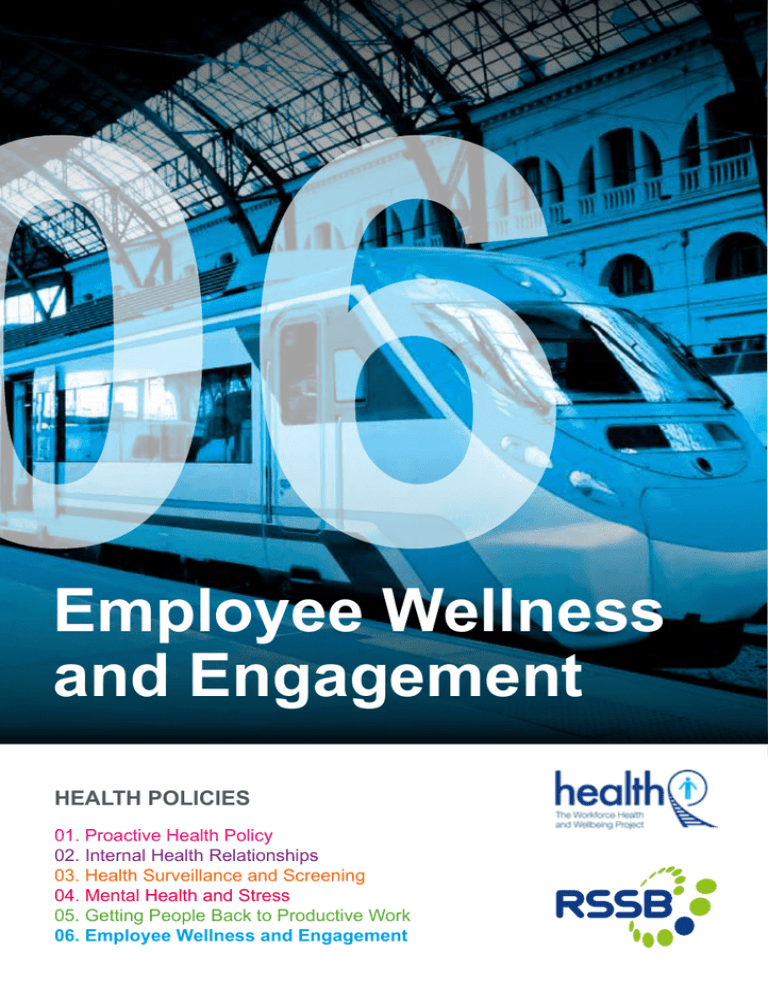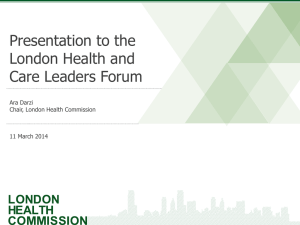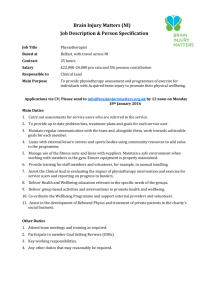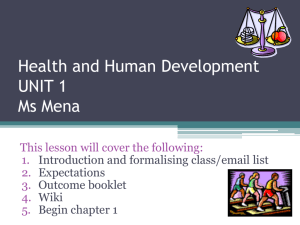Employee Wellness and Engagement HEALTH POLICIES 01. Proactive Health Policy
advertisement

Employee Wellness and Engagement HEALTH POLICIES 01. Proactive Health Policy 02. Internal Health Relationships 03. Health Surveillance and Screening 04. Mental Health and Stress 05. Getting People Back to Productive Work 06. Employee Wellness and Engagement 1 | Employee Wellbeing and Engagement Contents Understanding wellbeing is a key to change . 3 It is easier to engage with a good job than a poorly designed one . . . . . . . . . . 5 Physical health risks that go beyond legal requirements . . . . . . . . . . 7 Can wellbeing and engagement make a difference within your organisation? . . . . . 9 Learning from those that have made a change . . . . . . . . . . . . . . . . 11 Further information . . . . . . . . . . . . . . 13 Notes . . . . . . . . . . . . . . . . . . . . . 14 www.rssb.co.uk | 2 About the Proactive Health Policies booklet series Management of employee health and wellbeing is an important challenge for all organisations. Becoming proactive in health management can assist corporate responsibility, reduce company costs, increase productivity and, most importantly, improve people’s lives. involved engage with a similar set of ideas. These ideas will enable a flow of information and understanding that can push the health agenda forward. They highlight: This nest of six health policy booklets is designed to support organisations in becoming proactive in health management. They are a starting point to help the different disciplines • Good practice • Key focus areas • Important concepts • Useful tools and links Booklet 6 - Employee Wellbeing and Engagement Employee wellbeing and engagement has a broad reach, both within and outside the workplace. It encompasses an employee’s sense that their employer considers and cares about them, a recognition that work is good for them, and making positive lifestyle choices. There is a growing recognition by Government, the health service, and within the business community of the link between wellbeing, engagement and business performance. This document aims to provide the information to create a case for promoting employee wellbeing and engagement, and outlines the management approaches that organisations can use to provide benefit to both employer and employee. 3 | Employee Wellbeing and Engagement Understanding wellbeing is a key to change There are three elements that can improve a person’s wellbeing. Organisations can actively contribute to two of them. The three components of employee wellbeing, taken from Wellbeing, Productivity and Happiness at Work (Ivan Robertson and Cary Cooper, 2011), are said to be: 1. Psychological wellbeing – for example, the ability to handle the stresses of everyday life and maintain a positive attitude and sense of purpose. 2. Physical wellbeing – for example, the amount of exercise, sleeping habits, alcohol. 3. Social wellbeing – for example, a positive and supportive social network. Currently social wellbeing remains untouched by engagement improvement programmes as it is regarded as difficult to influence. Physical wellbeing is often managed by health fairs and relates to how an employee looks after themselves. Psychological wellbeing (PWB) relates to improving employee engagement and the removal of organisational stressors before they become a problem. When PWB is not well managed, workrelated stressors are considered to cause harm to psychological health. Work undertaken by BP and the HSE1 suggests that there is a degree of overlap between what are regarded as common workrelated stressors and recognised root causes of accidents. For example, ‘lack of training to do my job’ is a recognised work-related stressor. Having a lack of training is also a recognised potential root cause of accidents. BP goes on further to identify how improving PWB can reduce safety risks. www.rssb.co.uk You can look at the HSE health and BP health standards and consider their how they can be used within your organisation. Find them at: HSE: http://www.hse.gov.uk/stress/standards/ BP & HSE: http://www.hse.gov.uk/research/rrpdf/rr107.pdf The BP and HSE standards are found in Appedix 1 and cover the topics identified in figure 1. To make use of a free online wellbeing and resilience training tool use the site: Managing employee wellbeing Sponsored by Business in the Community, Aramark and Places for People, this site provides online learning materials for line managers who want to improve the way they manage employee wellbeing and enhance resilience in their team. It includes modules on: • What is good work? • What about me? (how managers can look after themselves) • What can I do proactively? (preventative behaviours/actions) • Should I be concerned? (spotting signs that an employee is struggling) • What do I do now? (what to do if an employee seems to be struggling) • Where does absence management fit in? Use the free tool at: http://www.managingemployeewellbeing.com/bitc/ | 4 5 | Employee Wellbeing and Engagement It is easier to engage with a good job than a poorly designed one Many people approach job roles as something that is fixed and the employee can like it or not. Thinking on this further and making alterations can increase employee wellbeing and engagement. An important component of wellbeing and engagement is job satisfaction. The Fair Society, Healthy Lives, (The Marmot Review) stated that ‘Work is good – and unemployment bad – for physical and mental health, but the quality of work matters2. The Work Foundation3 define a ‘good job’ as including: • Work that is not characterised by monotony and repetition • Autonomy, control and task discretion • A balance between the efforts workers make and the rewards they receive • Whether the workers have the skills they need to cope with periods of intense pressure • Strong workplace relationships (social capital) However, employees’ freedom to take decisions and organise their work, as an important component of engagement, is considered to be diminishing, according to British Skills Survey. The UK Commission for Employment and Skills also points to increasing evidence that individuals’ skills are being underutilised at work. This is not only a significant source of disengagement for the individuals affected, but also suggests significant wastage4. This raises the question ‘are organisations doing enough to create the conditions for role engagement and growth?’ www.rssb.co.uk Our views of work are always changing… Check out Industry’s Rail Technical Strategy (RTS). The RTS people section, highlights the need for professionalism and innovation in the rail industry. Review the people section of this technical strategy: http://www.futurerailway. org/RTS/About/ Documents/RTS%20 2012%20The%20 Future%20Railway.pdf | 6 7 | Employee Wellbeing and Engagement Physical health risks that go beyond legal requirements If organisations just stick to their legal requirements in regards to health they will be missing the point. There is increasing evidence that the management of employee wellness should go beyond that of work-related ill health, to factor in the impact of common health problems and lifestyle choices. If you have just started using health fairs within your organisation, or are looking to, then there is good evidence to support your work. Research by PwC commissioned by the Health, Work and Wellbeing Executive5 highlighted chronic disease as a major and rising source of health problems for adults, with 37% of deaths in the total population due to cardiovascular disease alone. Much of this, the research says, is due to an increase in poor lifestyle factors that are known risk factors for chronic disease, such as poor nutrition, smoking and lack of exercise. The research goes on to say that the cost of poor health of the workforce, through increased absenteeism and lowered job performance, is something employers can no longer ignore. In Dame Carol Black’s review of the health of the working age population, it is noted that lifestyle factors, such as smoking, drinking and obesity have a significant impact on health conditions experienced in this group6. Within RSSB’s Health conditions toolkit, the top five health conditions7 across industry were identified as musculoskeletal disorders, mental health issues, endocrine disorder, vascular disorders and sleep disorders, and a toolkit was developed to manage these conditions. Three of the five disorders: endocrine, vascular and sleep may not, fully or partially, be a direct responsibility of the organisation. www.rssb.co.uk | 8 About the NHS Health Check The NHS is the primary health provider within the UK, and should be used when possible for cost effective health engagement. For those wishing to direct employees to screening and health risk management advice, a good source of assistance is provided by the NHS Health Check. The check looks at vascular diseases (including coronary heart disease, stroke, diabetes and kidney disease), which currently affect the lives of over 4 million people in England. Vascular diseases together cause 36% of deaths (170,000 a year in England) and are responsible for a fifth of all hospital admissions. They are the largest single cause of long-term ill health and disability, impairing the quality of life for many people. The NHS Health Check aims to help everyone between the ages of 40 and 74 by assessing their risk of heart disease, stroke, diabetes, kidney disease and certain types of dementia, and giving them support and advice to manage that risk. Monitor health risks to better understand the causes of future ill health such as vascular disease (heart disease, strokes, diabetes) Find out how you can direct your employees to the service via the links below: http://www.screening.nhs.uk/vascularrisk http://www.healthcheck.nhs.uk/ 9 | Employee Wellbeing and Engagement Can wellbeing and engagement make a difference within your organisation? Organisations can start by making use of existing models and frameworks for wellbeing and engagement. David Macleod and Nita Clarke’s report for government: ‘Engaging for Success’, identifies a clear correlation between engagement and performance, and most importantly between improving engagement and improving performance. Engagement and wellbeing need to work together because ‘a sustainable approach to engagement must also include specific and substantial recognition of the need to maintain employee wellbeing’ (Robertson & Cooper, 2011). There is wealth of guidance on interventions that supports health promotion. As part of work commissioned by the Health Work and Wellbeing Executive, PwC has developed a framework for the implementation of wellbeing programmes, which it has tested amongst a number of organisations in different sectors8. They identify three key enablers which need to be in place before the implementation of a wellbeing programme: leadership, culture and communications. The MacLeod and Clarke report has identified four drivers/enablers of engagement that organisations can use to assess the effectiveness of their approach9, in summary these are: 1. Leadership: providing a strong strategic narrative which has widespread ownership and commitment from managers and employees at all level. 2. Engaging managers: managers who know how to engage others are at the heart of this organisational culture. 3. Voice: seeking employees’ views and listening to their answers, to develop an effective and empowered employee voice. 4. Integrity: behaviour throughout the organisation is consistent with stated values, leading to trust and a sense of integrity. An industry-led task force has developed a website ‘Engage for success’, which builds on this report10. Please make use of this site for its many useful resources. www.rssb.co.uk Get onto the engage for success website – type it into your search engine or follow the link below: http://www.engageforsuccess.org/ | 10 11 | Employee Wellbeing and Engagement Learning from those that have made a change Many organisations have made a change to more proactive wellbeing activities, and the evidence is there for all to see. Case study First ScotRail – reducing sickness absence and promoting wellbeing11 First ScotRail set out to manage employee health more proactively, reducing sickness absence due to stress, musculoskeletal injuries and lifestyle-related factors such as poor diet. They developed a people strategy, with input from key stakeholders including the four unions, to achieve a full understanding of issues and the most appropriate solutions. On site, the services of massage and chiropody were provided for all employees as well as hypnotherapy to help them stop smoking. They also set up a personal health challenge, involving a personal trainer who developed a fitness assessment and improvement plan for every employee who took part in the campaign. Formal policies were developed to manage sickness absence proactively with rehabilitation redeployment. A team of physiotherapists was brought on board with particular focus on occupational physiotherapy. A key element of the team’s work was to assess jobs at all locations – and to ensure treatments were incorporated in staff’s daily duties as much as possible. • Absence decreased from 6.2% to 4.1%, in 2010 saving around £3 million per annum Outcomes included: • 40% of cases referred to physiotherapy returned to work after an average of five sessions • In a survey, staff reported they felt ‘well looked after’ www.rssb.co.uk | 12 Case study Network Rail – health fairs Following an initial pilot, Network Rail have rolled out health fairs across all their sites. The fairs are used to promote health awareness through health screening, demonstrations, workshops on key topics, stalls run by charities, and raising awareness of the occupational and wellbeing resources available to staff. The fairs also aim to motivate healthy behaviours and teach self-care practices. The feedback from staff received has been good. A comprehensive guide has been developed to help managers set up health fairs. Case study South West Trains – health fairs South West Trains run their health fairs using a double decked bus which goes around their sites. This has proved to be popular with staff. To support this, South West Trains has produced a booklet which includes a health check section, where staff can record their health condition covering BMI, cholesterol and cardiac risk assessment. The booklet provides information on keeping healthy, managing stress and how to manage shiftwork. Many organisations have taken the step to undertake health fairs to promote employee wellbeing. However, joined-up activities to monitor and enhance the business benefits of employee physical wellbeing are not obvious within the industry. For example, health fairs can identify indicators for future health problems that will cause sickness absence in the future. 13 | Employee Wellbeing and Engagement Further Information CIPD provides a factsheet on employee engagement. http://www.cipd.co.uk/hr-resources/factsheets/employee-engagement.aspx CIPD provide the business case for wellbeing at work – how to obtain buy-in (need to be a member). http://www.cipd.co.uk/hr-resources/axa/business-case-how-obtain-buy-in. aspx PwC framework for implementing a wellness programme. http://www.dwp.gov.uk/docs/hwwb-dwp-wellness-report-public.pdf Engage for Success website provides tools, ideas and evidence for employee engagement. http://www.engageforsuccess.org/ BITC Workwell movement and model, evidence for action, resources and case studies. http://www.bitc.org.uk/workplace/health_and_wellbeing/index.html NICE - Workplace interventions to promote smoking cessation PH5, 2007. Provides guidance on actions to support smoking cessation and a simple business case for employers. http://www.nice.org.uk/Guidance/PH5 NICE - Promoting physical activity in the workplace PH13, 2008. Provides guidance for employers and workplace health professional on how to promote physical activities in workplace. http://guidance.nice.org.uk/PH13 IOSH provides an occupational toolkit for non-work related conditions including heart disease, stroke, pregnancy, MSD, skin disorders, and stress. NHS Health for work - Adviceline provides guidance on health promotion initiatives. http://www.health4work.nhs.uk/ Healthy people = Healthy Profits, BITC - Business Action on Health, 2009 provides 20 case studies, as examples of best practice with documented business benefits, following introduction of health and wellbeing interventions in workplace. www.rssb.co.uk | 14 Notes HSE, 2003, Development of internal company standards of good management practice and a task-based risk assessment tool for offshore work-related stressors. HMSO. Norwich 1 Fair Society, Healthy Lives, The Marmot Review, 2010: http://www.instituteofhealthequity. org/projects/fair-society-healthy-lives-the-marmot-review 2 3 ‘Good work’: job quality in a changing economy, The Work Foundation, 2008 Engaging for success: Enhancing performance through employee engagement. A report for government by David Macleod and Nita Clarke, 2009 4 5 Building the case for wellness, PWC, 2008 Working for a Healthier Tomorrow: Review of the Health of Britain’s Working Age Population, Black, Carol 2008. 6 7 Management of health conditions and diseases, RSSB , 2006 8 Building the case for wellness, PWC, 2008 Engaging for success: Enhancing performance through employee engagement, A report for Government by David Macleod and Nita Clarke, 2009. 9 10 http://www.engageforsuccess.org/ Adapted from First Group – First ScotRail reducing sickness absence and promoting a healthy workforce. http://www.rail-reg.gov.uk/upload/pdf/oh-casestudy-firstscotrail.pdf 11 0 RSSB Block 2 Angel Square 1 Torrens Street London EC1V 1NY www.rssb.co.uk








